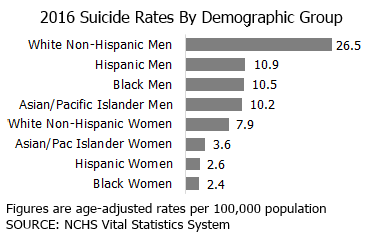Suicide Rate Highest in Decades but Worst in Rural America
Mike Maciag, Governing, February 7, 2018
{snip}
Suicide is a perennial problem throughout the nation. The latest Centers for Disease Control and Prevention (CDC) data shows the 2016 national age-adjusted suicide rate reached the highest level seen in decades.
A review of the federal data, however, shows that it’s rural America that is sustaining the largest increases. The aggregate suicide rate for counties outside of metropolitan areas climbed about 14 percent over the five-year period ending in 2016. By comparison, the rate within metro areas also increased — but only by 8 percent. The largest metro areas, in particular, experienced relatively small increases compared to everywhere else.
The suicide rate is highest in the Western U.S., with Montana (26 deaths per 100,000), Alaska (25.4 deaths per 100,000) and Wyoming (25.2 deaths per 100,000) recording the highest rates. Rates were about three times lower in the more urban states of Massachusetts, New Jersey and New York.
White men die at the highest rates — roughly 10 times that of Hispanic women and black women — because they tend to have greater access to firearms. Women, on the other hand, carry out more suicide attempts but generally do so using less lethal means.
Gun ownership, which is more prevalent in rural areas, also explains why certain regions have higher suicide rates. Firearms account for about half of all suicide deaths. Research has found that mandating waiting periods, gun locks and other gun control laws are associated with fewer deaths.
{snip}
Princeton University professors Anne Case and Angus Deaton have conducted extensive research around what they call “deaths by despair” — suicides, drug overdoses and alcohol-related fatalities. They found mortality among non-Hispanic whites to be rising for those without college degrees, and improving for more educated whites, blacks and Hispanics. The cumulative effects of few labor market opportunities and weakening social structures have largely contributed to worsening mortality for less-educated whites, although the authors note that economics alone don’t fully explain increasing suicide rates.
{snip}
Studies have singled out other issues compounding the problem. Marriage rates, for instance, have declined, and unmarried middle-aged men have been shown to be at particularly high risks of suicide.
{snip}
West Virginia’s suicide rate — historically one of the nation’s highest — has continued its slow upward ascent in recent years. About two-thirds of the state’s fatalities involve firearms, so Barri Faucett, director of Prevent Suicide West Virginia, says her group is working to distribute gun locks and promote the idea that those suffering from mental health problems shouldn’t have immediate access to firearms. “We’re not telling people to get rid of their guns,” she says. “We’re just wanting to ensure that they’re kept safe during a critical time.”
{snip}
[Editor’s Note: A graph by regionand an interactive map accompany the original story.]
















